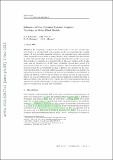Files in this item
Influence of non-potential coronal magnetic topology on solar wind models
Item metadata
| dc.contributor.author | Edwards, Sarah Jane | |
| dc.contributor.author | Yeates, Anthony Robinson | |
| dc.contributor.author | Bocquet, Francois | |
| dc.contributor.author | Mackay, Duncan Hendry | |
| dc.date.accessioned | 2016-10-28T23:34:00Z | |
| dc.date.available | 2016-10-28T23:34:00Z | |
| dc.date.issued | 2015-10 | |
| dc.identifier | 223509487 | |
| dc.identifier | 8f508707-a622-4723-bec3-6fa011ac407a | |
| dc.identifier | 84947491423 | |
| dc.identifier | 000365220000009 | |
| dc.identifier.citation | Edwards , S J , Yeates , A R , Bocquet , F & Mackay , D H 2015 , ' Influence of non-potential coronal magnetic topology on solar wind models ' , Solar Physics , vol. 290 , no. 10 , pp. 2791-2808 . https://doi.org/10.1007/s11207-015-0795-8 | en |
| dc.identifier.issn | 0038-0938 | |
| dc.identifier.other | ORCID: /0000-0001-6065-8531/work/58055432 | |
| dc.identifier.uri | https://hdl.handle.net/10023/9729 | |
| dc.description.abstract | By comparing a magneto-frictional model of the low coronal magnetic field to a potential field source surface model, we investigate the possible impact of non-potential magnetic structure on empirical solar wind models. These empirical models (such as Wang-Sheeley-Arge) estimate the distribution of solar wind speed solely from the magnetic field structure in the low corona. Our models are computed in a domain between the solar surface and 2.5 solar radii, and are extended to 0.1 AU using a Schatten current sheet model. The non-potential field has a more complex magnetic skeleton and quasi-separatrix structures than the potential field, leading to different sub-structure in the solar wind speed proxies. It contains twisted magnetic structures which can perturb the separatrix surfaces traced down from the base of the heliospheric current sheet. A significant difference between the models is the greater amount of open magnetic flux in the non-potential model. Using existing empirical formulae this leads to higher predicted wind speeds for two reasons: partly because magnetic flux tubes expand less rapidly with height, but more importantly because more open field lines are further from coronal hole boundaries. | |
| dc.format.extent | 18 | |
| dc.format.extent | 1811132 | |
| dc.language.iso | eng | |
| dc.relation.ispartof | Solar Physics | en |
| dc.rights | © 2015, Publisher / the Author(s). This work is made available online in accordance with the publisher’s policies. This is the author created, accepted version manuscript following peer review and may differ slightly from the final published version. The final published version of this work is available at link.springer.com / https://dx.doi.org/10.1007/s11207-015-0795-8 | en |
| dc.subject | Corona, models | en |
| dc.subject | Magnetic fields, corona | en |
| dc.subject | Magnetic fields, interplanetary | en |
| dc.subject | Magnetic fields, models | en |
| dc.subject | Solar wind, theory | en |
| dc.subject | QB Astronomy | en |
| dc.subject | QC Physics | en |
| dc.subject | 3rd-DAS | en |
| dc.subject.lcc | QB | en |
| dc.subject.lcc | QC | en |
| dc.title | Influence of non-potential coronal magnetic topology on solar wind models | en |
| dc.type | Journal article | en |
| dc.contributor.sponsor | Science & Technology Facilities Council | en |
| dc.contributor.sponsor | Science & Technology Facilities Council | en |
| dc.contributor.institution | University of St Andrews.Applied Mathematics | en |
| dc.identifier.doi | 10.1007/s11207-015-0795-8 | |
| dc.description.status | Peer reviewed | en |
| dc.date.embargoedUntil | 2016-10-28 | |
| dc.identifier.url | http://link.springer.com/article/10.1007/s11207-015-0795-8 | en |
| dc.identifier.grantnumber | ST/K000950/1 | en |
| dc.identifier.grantnumber | PO: 4070103637 | en |
This item appears in the following Collection(s)
Items in the St Andrews Research Repository are protected by copyright, with all rights reserved, unless otherwise indicated.

